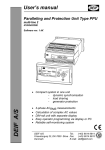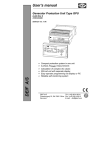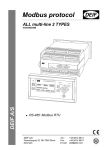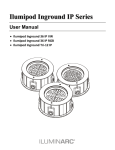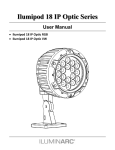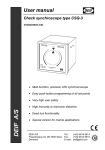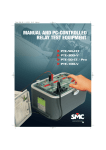Download Generator Paralleling Controller (GPC)
Transcript
User’s manual Generator Paralleling Controller Type GPC multi-line 2 4189340226C Software ver. 1.3X DEIF A/S • Compact system in one unit - dynamic synchronisation - load sharing - generator protection • • • • • 3-phase ACRMS measurements Calculation of complex AC values DIN-rail unit with separate display Easy operator programming via display or PC Reliable self-monitoring system DEIF A/S Tel: (+45) 9614 9614 Frisenborgvej 33, DK-7800 Skive Fax: (+45) 9614 9615 Denmark E-mail: [email protected] GPC – User’s manual This document is the user’s manual for the standard Deif Multi-line 2 GPC. INDEX: WARNINGS AND LEGAL INFORMATION ................................................................................. 5 STANDARD FUNCTIONS ........................................................................................................... 5 LANGUAGE ............................................................................................................................... 5 CONTROL FUNCTIONS ............................................................................................................... 5 GENERATOR PROTECTION FUNCTIONS ........................................................................................ 6 OPTIONAL FUNCTION LIST ...................................................................................................... 6 OPTION A, MAINS FAILURE SUPERVISION..................................................................................... 6 OPTION B, BUS PROTECTION PACKAGE ..................................................................................... 6 OPTION D, VOLTAGE/VAR/POWER FACTOR CONTROL ................................................................... 6 OPTION E, ANALOGUE GOVERNOR AND AVR CONTROL OUTPUTS ................................................. 7 OPTION F1, 2 X TRANSDUCER OUTPUT ....................................................................................... 7 OPTION G, START / STOP OF NEXT GENERATOR .......................................................................... 7 OPTION H1, CAN-BUS SERIAL INTERFACE .................................................................................. 7 OPTION J1, DISPLAY CABLE, 3 M ................................................................................................ 7 OPTION J2, DISPLAY CABLE, 6 M ................................................................................................ 7 HARDWARE ............................................................................................................................... 8 TERMINAL STRIP OVERVIEW................................................................................................. 10 SLOTS 1,2,5 AND 6 ................................................................................................................. 10 SLOTS 3,4 AND 8 .................................................................................................................... 11 TERMINAL STRIP, EXPLANATION.......................................................................................... 12 SLOT #1, POWER SUPPLY AND BINARY I/O ................................................................................ 12 SLOT #2, SERIAL COMMUNICATION (OPTION H) ......................................................................... 13 CAN-bus (Option H1): ...................................................................................................... 13 SLOT #3, LOAD SHARING CONTROL .......................................................................................... 14 SLOT #4, ANALOG SPEED GOVERNOR / AVR (OPTION E) ........................................................... 16 SLOT #5, AC MEASURING........................................................................................................ 17 SLOT #6, ANALOGUE TRANSDUCER OUTPUT (OPTION F1)........................................................... 18 SLOT #8, AVR CONTROL RELAY OUTPUTS (OPTION D)............................................................... 18 WIRINGS................................................................................................................................... 19 AC CONNECTIONS .................................................................................................................. 19 LOAD SHARING LINES .............................................................................................................. 20 BINARY INPUTS ....................................................................................................................... 20 ANALOGUE INPUTS (EXTERNAL SET-POINTS) ............................................................................. 21 0…10V DC input using potentiometer: ............................................................................. 21 +/- 10V input using potentiometer:.................................................................................... 21 OPTOCOUPLER OUTPUTS FOR EXTERNAL COUNTER ................................................................... 22 DISPLAY I/F CABLE.................................................................................................................. 22 PC I/F CABLE ......................................................................................................................... 23 4189340226C Page 2/48 GPC – User’s manual DISPLAY UNIT.......................................................................................................................... 23 PUSH-BUTTON FUNCTIONS....................................................................................................... 24 DISPLAY FUNCTIONS ............................................................................................................... 24 First line in display (daily use display functions)................................................................ 24 Second line in display (daily use display) ......................................................................... 25 Second line in display (menu system) .............................................................................. 25 Second line in display (alarm and event list)..................................................................... 26 Third line in display (daily use display) ............................................................................. 26 Third line in display (parameter menu display) ................................................................. 26 Fourth line in display (daily use display) ........................................................................... 27 Fourth line in display (parameter menu display) ............................................................... 27 MENU OVERVIEW .................................................................................................................... 28 PASSWORD SETTING ............................................................................................................... 28 NAVIGATING IN THE MENUS ...................................................................................................... 29 Setup menu system ......................................................................................................... 29 MENU SET-POINTS.................................................................................................................. 30 PROTECTIONS ........................................................................................................................ 30 Mains/BUS voltage protection option A or B ..................................................................... 30 Mains/BUS frequency protection option A or B................................................................. 31 Generator reverse power protection ................................................................................. 32 Generator overcurrent protection...................................................................................... 32 Loss of mains protection option A..................................................................................... 32 Generator voltage protection options A and B .................................................................. 33 CONTROL FUNCTIONS ............................................................................................................. 35 Synchronisation................................................................................................................ 35 Blackout closing of breaker .............................................................................................. 35 General failure (sync fail) ................................................................................................. 35 Frequency controller ........................................................................................................ 36 Power controller ............................................................................................................... 36 Power ramp up................................................................................................................. 37 Power ramp down ............................................................................................................ 37 Power / frequency control mix factor................................................................................. 37 Voltage controller option D ............................................................................................... 38 var controller option D ...................................................................................................... 38 var / voltage control mix factor.......................................................................................... 38 Power Factor (PF) controller option D .............................................................................. 39 Load dependent start/stop of next generator option G ...................................................... 39 Nominal Settings .............................................................................................................. 40 Transformer ..................................................................................................................... 40 Controller settings ............................................................................................................ 40 CAN-bus communication enables / disables control (option H1)....................................... 41 CAN-bus communication setup (option H1)...................................................................... 41 Date and time (internal clock) setting................................................................................ 41 Battery undervoltage alarm .............................................................................................. 41 Language ......................................................................................................................... 42 ANALOGUE OUTPUT OPTION F1 ................................................................................................ 42 Power (P kW) output ........................................................................................................ 42 Apparent Power (S kVA) output........................................................................................ 42 4189340226C Page 3/48 GPC – User’s manual Reactive Power (Q kvar) output........................................................................................ 42 Power factor (PF) output .................................................................................................. 43 Frequency output ............................................................................................................. 43 Voltage output.................................................................................................................. 43 Current output .................................................................................................................. 43 USER PASSWORD ................................................................................................................... 44 GENERAL DATA ...................................................................................................................... 45 TECHNICAL SPECIFICATIONS .................................................................................................... 45 UNIT DIMENSIONS ................................................................................................................... 47 DISPLAY DIMENSIONS .............................................................................................................. 47 PANEL CUTOUT FOR DISPLAY ................................................................................................... 48 4189340226C Page 4/48 GPC – User’s manual Warnings and legal information This manual gives guidelines to installation of the DEIF Multi-line 2 generator control and protection units. It is, however, not a complete installation instruction. Therefore, even if terminal numbers are shown in the drawings, the drawings are to be used as guidance only. Installing and operating the Multi-line 2 products implies work with dangerous currents and voltages, and therefore it should be done by qualified personnel only. Care must be taken during installation to protect the terminals against static discharges. Once the units is installed and connected, these precautions are no longer necessary. DEIF takes no responsibility for operation or installation of the generator set. If there is any doubt about how to install or operate the system on which the Multi-line 2 products are measuring, the company responsible for installation or operation must be contacted. Standard functions The GPC is a control and protection unit for a generator driven by a diesel / gas engine or a turbine. The GPC will carry out all necessary tasks to control and protect a generator, regardless of the use of the generator. This means that the GPC can be used for several application types such as: Stand-alone generator Multiple generator load sharing control Fixed load to mains / base load The GPC measuring system is true RMS 3-phase measurement of generator voltage, generator current and BUS (mains) voltage. Language German or English language may be chosen via the system menu structure. Control functions - - Dynamic synchronisation o Frequency matching o Voltage check o Breaker delay time compensation o Check phase sequence Fixed load (base load) running of the generator Fixed frequency running of a stand-alone generator Load sharing between generators with power and frequency control Relay outputs for speed governor Relay outputs to close / open generator breaker Adjustable ramp up/down of generator load Relay outputs for start / stop of next generator (high / low load) 4189340226C Page 5/48 GPC – User’s manual Generator protection functions - Reverse power Overcurrent (2 levels) Protective functions can be selected to activate one of 4 configurable relays. Optional function list Option A and option B cannot be chosen at the same time as some functions are common for both. Option A, mains failure supervision - Vector jump Df/dt (ROCOF) Overvoltage (2 levels) Undervoltage (2 levels) Overfrequency (2 levels) Underfrequency (2 levels) Option B, BUS protection package - Overvoltage (2 levels) Undervoltage (2 levels) Overfrequency (2 levels) Underfrequency (2 levels) Option D, Voltage/var/power factor control The selection of which of the option D functions is active is dependent on the running mode selection (mode inputs 4,5, and 6). Please refer to I/O list for specific connection of the inputs. 4189340226C Page 6/48 GPC – User’s manual Option E, analogue governor and AVR control outputs Selecting option E means that an additional board will be placed in slot #4 (terminals 65 to 72) where 2 analogue +/- 20 mA control outputs will be present. The outputs are galvanically separated from each other and the rest of the GPC. The outputs are active outputs (does not require external power supply). Option F1, 2 x transducer output Selecting option F1 means that an additional board will be placed in slot #6 (terminals 90 to 97) where 2 analogue 0(4)…20 mA outputs will be present. The outputs are galvanically separated from each other and the rest of the GPC. The outputs are active outputs (does not require external power supply). The use of the analogue outputs can be selected via the menu system or the PC programming interface. Option G, Start / stop of next generator If option G is selected, relay outputs terminal 61-62 (start) and 63-64 (stop) are used. Both are normally open relays. The settings of level and timers can be carried out in the menu system or via PC interface. Option H1, CAN-bus serial interface If option H1 is selected, an additional communication board is mounted in slot #2 (terminals 2936). For technical details regarding the CAN-bus interface, please see the CAN-bus manual. Option J1, display cable, 3 m Cable with male / female SUB-D plugs. Option J2, display cable, 6 m Cable with male / female SUB-D plugs. 4189340226C Page 7/48 GPC – User’s manual Hardware The GPC unit housing is divided into board slot positions, some of which are standard (nonchangeable) and some intended for options. The unit is divided like this: Slot #1: Standard Slot #2: Slot #3: Slot #4: Slot #5: Standard Slot #6: Slot #7: Not used Slot #8: Terminal 1-28 Terminal 29-36 Terminal 37-64 Terminal 65-72 Terminal 73-89 Terminal 90-97 Terminal 98-125 Terminal 126-133 In the standard GPC, the only slots used are as standard slot #1, #3, #5 and #8. Slots #2, #4 and #6 are used for options, slot # 7 is not used. Besides the slots, there is an additional board where the communication (RS 232 PC service port for programming of setpoints and timers etc. and display) is placed. NOTE: For slots #1, 3 and 5, only specific boards can be mounted. For slots #2, 4, 6 and 8, the boards are interchangeable. An overview of the terminals can be seen on the next page. 4189340226C Page 8/48 SLOT #5 SLOT #7 5 6 7 8 9 10 11 12 13 14 98 112 113 114 115 116 117 118 119 120 121 122 123 124 125 85 86 87 88 89 DISPLAY 126 127 128 129 130 131 132 133 90 91 92 93 94 95 96 97 65 66 67 68 69 70 71 72 51 52 53 54 55 56 57 58 59 60 61 62 63 64 Service port 29 30 31 32 33 34 35 36 15 16 17 18 19 20 21 22 23 24 25 26 27 28 79 80 81 82 83 84 99 100 101 102 103 104 105 106 107 108 109 110 111 73 74 75 76 77 78 37 38 39 40 41 42 43 44 45 46 47 48 49 50 4 er Po w ok ch ec k Se lf SLOT #1 SLOT #3 3 Al ar m inh ibi t 1 2 SLOT #6 SLOT #8 SLOT #2 SLOT #4 GPC – User’s manual The slots are positioned in the unit as follows (seen from the top of the unit): 4189340226C Page 9/48 GPC – User’s manual Terminal strip overview Slots 1,2,5 and 6 4189340226C Page 10/48 GPC – User’s manual Slots 3,4 and 8 4189340226C Page 11/48 GPC – User’s manual Terminal strip, explanation For the relay outputs, following terms will be used: NO means Normally Open NC means Normally Closed Com. means common terminal for the relay in question Slot #1, power supply and binary I/O Standard board (always needed): Term Function Technical data Description 24V DC +20 / - 30 % Power supply. 1 +24V DC 2 0V DC 3 NC Status relay Normally closed relay, processor /power supply status supervision 24V / 1A 4 Com 5 NO Relay 1, Configurable 250V AC / 8A 6 Com. 7 NC Relay 2, Configurable 8 NO 250V AC / 8A 9 Com. 10 NC 11 NO Relay 3, Configurable 250V AC / 8A 12 Com. 13 NC Relay 4, Open breaker (De-load) 14 NO 250V AC / 8A Can be configured for tripping 15 Com. also. 16 NC 17 NO Relay 5, Close breaker (synchronising) 250V AC / 8A 18 Com. 19 NC 20 Open collector 1 Transistor out Pulse output 1, kWh counter 21 Open collector 2 Transistor out Pulse output 2, kvarh counter 22 Com. Common Common terminal for terminals 21 and 22 23 Digital input 1 Optocoupler Remote alarm inhibit 24 Digital input 2 Optocoupler Remote alarm acknowledge 25 Digital input 3 Optocoupler Start sync. / control functions 26 Digital input 4 Optocoupler Spare 27 Digital input 5 Optocoupler Block loss of mains (Vector jump and df/dt (ROCOF) only) (option A) 28 Com Common Common for terminals 24 to 27 NOTE: If input terminal 25 (start sync./control) is not activated, all control functions are disabled. This includes the terminal 43 de-load function. 4189340226C Page 12/48 GPC – User’s manual The GPC monitors the energy production of each unit and it has pulse outputs for kWh and kVARh measurement. The number of pulses depends on the nominal output of the generator as follows: Pnom Pnom Pnom < 100 kW → 100-1000 kW → > 1000 kW → 1 pulse/kW 1 pulse/10 kW 1 pulse/100 kW The pulse length is 1 s/pulse. Slot #2, Serial communication (option H) CAN-bus (Option H1): Term. 29 30 31 32 33 34 35 36 Function CAN-H GND CAN-L CAN-H GND CAN-L Not used Not used Description The CAN-bus is based on CAN 2.0 B passive. The protocol is adapted for Deif use and can be provided. Contact Deif for further details. 4189340226C Page 13/48 GPC – User’s manual Slot #3, load sharing control Term. 37 38 39 40 41 42 Function Technical data -5…0…5V DC Analogue I/O Com Common -5…0…5V DC Analogue I/O -10…0…10V DC Analogue input Com Common -10…0…10V DC Analogue input 43 44 Binary input 6 Binary input 7 Optocoupler Optocoupler 45 Binary input 8 Optocoupler 46 Binary input 9 Optocoupler 47 Binary input 10 Optocoupler 48 49 50 51 52 53 54 55 56 57 58 59 60 61 62 63 64 Binary input 11 Binary input 12 Binary input 13 Binary input 14 Binary input 15 Binary input 16 Binary input 17 Binary input 18 Com NO Com NO Com NO Com NO Com Optocoupler Optocoupler Optocoupler Optocoupler Optocoupler Optocoupler Optocoupler Optocoupler Common Relay no. 6 250 VAC 8A Relay no. 7 250 VAC 8A Relay no. 8 250 VAC 8A Relay no. 9 250 VAC 8A Description Active load sharing line Common for load sharing lines Reactive load sharing Frequency / Active load set-point. Passive (requires external power supply) Common for terminals 40 and 42 Voltage /var/Power factor/Reactive load set-point. Passive (requires external power supply) De-load (not possible in freq-control mode) Manual raise speed (only active when “start sync. /reg.” is OFF) Manual lower speed (only active when “start sync. /reg.” is OFF) Manual raise voltage (only active when “start sync. /reg.” is OFF) Manual lower voltage (only active when “start sync. /reg.” is OFF) Mode 1 Mode 2 Mode 3 Mode 4 Mode 5 Mode 6 Generator breaker open Generator breaker closed Common for terminals 43 to 55 Engine speed governor: Raise speed Engine speed governor: Lower speed Start next generator (high load) Stop next generator (low load) NOTE: The terminal 43 de-load function will ramp the generator down and open the breaker. If the function is left ON after opening of breaker, it will prevent re-synchronisation. Mode 1-6: These controls are only active when the breaker is closed and the "activate controls" input is ON. Control selections with mode 1-6 inputs: See next page 4189340226C Page 14/48 GPC – User’s manual Power / frequency mode selection Fixed frequency Base load (Fixed Power) Droop Load sharing Mode 1 Mode 2 OFF ON OFF ON OFF OFF ON ON Power / frequency modes Internal set-point External (terminals 40(signal) and 41(gnd)) set-point External set-point values: Mode Input Fixed frequency -10…0…+10V DC Base load (Fixed Power) 0…10V DC Droop -10…0…+10V DC Load sharing -10…0…+10V DC Voltage/var/power factor mode selection (option D) Fixed voltage Fixed var control Fixed power factor control var sharing Mode 3 OFF Mode 3 ON Value - 5…0…+5 Hz related to nominal frequency 0…100% load related to nominal power - 5…0…+5 Hz related to nominal frequency - 5…0…+ 5Hz related to nominal frequency Mode 4 Mode 5 OFF ON OFF OFF OFF ON ON ON Voltage/var/power factor modes (option D) Internal set-point External (terminals 41(signal) and 42(gnd)) set-point Mode 6 OFF Mode 6 ON External set-point values: Mode Input Fixed voltage -10…0…+10V DC Fixed var control 0…10V DC Fixed power factor 0…+10V DC control var sharing -10…0…+10V DC Value - 10…0…+10 % related to nominal voltage 0…100% load related to nominal power Cos ϕ 1.0…0.6 inductive - 10…0…+10 % voltage setting related to nominal voltage External set point inputs are passive and require an external power source (+/- 10 VDC) 4189340226C Page 15/48 GPC – User’s manual Slot #4, Analog speed governor / AVR (option E) These outputs are active outputs i.e. they use the internal power supply. The outputs are galvanically separated from each other and the rest of the unit. The current outputs can if needed be converted to voltage using a resistor across the terminals (250 Ω will convert the +/- 20 mA into +/- 5 VDC). Term. 65 66 67 68 69 70 71 72 Note1): Function Not used +/- 20 mA out 0 Not used Not used +/- 20 mA out 0 Not used Description Speed governor set-point output. AVR voltage set-point output.1) Voltage control set-point to AVR is an option (option F). If the combination of analogue speed governor signals and relay AVR signals (or vice versa) is needed, the analog signal is carried out using the slot #4 analogue output and relay output control is carried out with relay 6/7 (speed) or 8/9 (voltage) in slot #3. 4189340226C Page 16/48 GPC – User’s manual Slot #5, AC measuring Term. 73 74 75 76 77 78 79 80 81 82 83 84 85 86 87 88 89 Note: Function I L1 s1 I L1 s2 I L2 s1 I L2 s2 I L3 s1 I L3 s2 U L1 U L2 U L3 U Neutral U L1 U L2 U L3 Technical description Generator current L1 Description 1/5 A AC input. Generator current L2 1/5 A AC input. Generator current L3 1/5 A AC input. Generator voltage L1 Not used Generator voltage L2 Not used Generator voltage L3 Generator voltage neutral BUS voltage L1 Not used BUS voltage L2 Not used BUS voltage L3 Max. 690 VAC phase - phase value Max. 690 VAC phase - phase value Max. 690 VAC phase - phase value For land-based applications only. Max. 690 VAC phase - phase value Max. 690 VAC phase - phase value Max. 690 VAC phase - phase value Current inputs are galvanically separated. Max. 0.3 VA per phase. Voltage measurements are available in 4 levels: 100 to 110V AC 200 to 240V AC 380 to 480V AC 660 to 690V AC Voltage level to be defined when ordering, but can be changed onsite. 4189340226C Page 17/48 GPC – User’s manual Slot #6, analogue transducer output (option F1) These outputs are active outputs i.e. they use the internal power supply. The outputs are galvanically separated from each other and the rest of the unit. The individual output can be selected (in display or via PC programming software) to represent any AC measuring value and related values (e.g. power, power factor, frequency, etc….). For actual selection refer to the programming manual. Via software selection, the outputs can be selected to be 0…20 mA or 4…20 mA. The current output can if needed be converted to voltage using a resistor across the terminals (250 Ω will convert the 0 - 20 mA into 0 - 5V DC). The outputs can, by moving a jumper on the board, be selected to be +/- 20 mA if needed. Term. Slot #6 90 91 92 93 94 95 96 97 Function Not used 0(4) - 20 mA out 0 Not used Not used (4) - 20 mA out 0 Not used Description Analogue output, selectable. Analogue output, selectable. Slot #8, AVR control relay outputs (option D) Term. Slot #6 126 127 128 129 130 131 132 133 Function Technical data Description NO Com NO Com Not used Not used Not used Not used Relay 10 250V AC, 8A Relay 11 250V AC, 8A AVR voltage increase AVR voltage decrease 4189340226C Page 18/48 GPC – User’s manual Wirings AC connections BU SBA R L2 L3 L1 N PPU 8 9 U L3 8 7 U L2 BU SBA R V O LTA G E 8 5 U L1 18 19 BR EA KER ON 15 16 BR EA KER O FF 84 N 8 3 U L3 8 1 U L2 s2 s1 s2 7 9 U L1 78 I3 77 76 s1 I2 75 s2 74 s1 G EN ER A TO R V O LTA G E G EN ER A TO R C U RR EN T I1 73 G EN ER A TO R Notes: The neutral line (N) connection is not necessary for correct measurement. 3phase without neutral is also possible. The current transformers ground connection can be on s1 or s2 connection, whichever is preferred. Fuses: 2A slow-blow. 4189340226C Page 19/48 GPC – User’s manual Load sharing lines Even though screened cable is not needed, it is recommended if the cable run is longer than 5 m between units. Binary inputs All binary inputs are 24 VDC bi-directional optocoupler. Typical input is: 4189340226C Page 20/48 GPC – User’s manual Analogue inputs (external set-points) The set-point inputs are passive, i.e. an external power source is needed. This can be an active output from e.g. a PLC, or a potentiometer can be used. 0…10V DC input using potentiometer: +/- 10V input using potentiometer: 4189340226C Page 21/48 GPC – User’s manual Optocoupler outputs for external counter The kWh counter (terminals 21-23) and kvarh counter (terminals 21-22) outputs are low-power outputs. For that reason the following circuit must be applied: + 24 VD C EX TER N A L C O U N TER 0 .5 u F 100V PPU 2 0 (kW h) 2 2 (C O M M O N ) O VD C Display I/F cable A standard computer extension cable can be used (9-pole SUB-D male / female plugs) or a cable can be tailored: Wires min 0.22 mm2, max cable length 3m. Cable types: Belden 9540, BICC H8146, Brand Rex BE57540 or equivalent. 4189340226C Page 22/48 GPC – User’s manual PC I/F cable A standard computer null-modem cable can be used (9-pole SUB-D female / female plugs) or a cable can be tailored: Display unit The display unit used in multi-line 2 communicates and receives power supply via a 9-pole Sub-D plug. The plug fits directly onto the main unit, so the display can be mounted on the top of the main unit. If the display is to be used as remote display, a standard computer extension cable with male / female plug can be used for the connection. Display dimensions HxWxD = 115 x 220 x 20 mm 4189340226C Page 23/48 GPC – User’s manual Push-button functions There are 10 pushbuttons on the display unit with the following functions: INFO: Shifts the display 3 lower lines to show the alarm list (up to 30 alarms can be in the list). JUMP: Enters a menu number selection. All settings have a specific number attached to it. Using the JUMP button enables the user to select and display any setting without navigating all the way through the menus (see later). VIEW: Shifts the upper line displaying. The following values can be shown: 3 generator voltages (phase-to-phase) 3 BUS voltages (phase-to-phase) 3 generator currents Generator power factor and produced power (kW) Generator apparent power (VA) and reactive power (kvar) Generator L1 frequency and voltage BUS L1 frequency and voltage - LOG: Shifts the display 3 lower lines to show the event and alarm list : Moves the cursor left for manoeuvring in the menus. : Increases the value of the selected set-point (in the setting menus). In the daily use display it is used for scrolling the second line displaying of generator values. SEL: Is used to select the chosen function (underscored selection in the lower line of the display). : ESC: : Decreases the value of the selected set-point (in the setting menus). In the daily use display it is used for scrolling the second line displaying of generator values. Jumps backwards one step in the menu (to previous display). Moves the cursor right for manoeuvring in the menus. Display functions First line in display (daily use display functions) The first line is used to display generator and BUS values. Typically the line will show 2 or 3 different values at the same time The following line values can be seen: 4189340226C Page 24/48 GPC – User’s manual - Generator voltage L1 L2 L3 (VAC) - BUS voltage L1 L2 L3 (VAC) - Generator current L1 L2 L3 (A) - Generator Power Factor and active power (kW) - Generator apparent power (kVA) and reactive power (kvar) - Generator L1 frequency (Hz) and voltage (VAC) - BUS L1 frequency (Hz) and voltage (VAC) Second line in display (daily use display) The second line is a service line where various values can be shown. Scrolling is done using the and keys. The values available are: For generator: For BUS: voltage L1-N (VAC) voltage L2-N (VAC) voltage L3-N (VAC) voltage L1-L2 (VAC) voltage L2-L3 (VAC) voltage L3-L1 (VAC) voltage max. (VAC) voltage min. (VAC) current L1 (A) current L2 (A) current L3 (A) frequency L1 (Hz) frequency L2 (Hz) frequency L3 (Hz) active power (kW) reactive power (kvar) apparent power (kVA) energy counter (kWh) power factor voltage angle between L1-L2 (deg.) voltage angle between L2-L3 (deg.) voltage angle between L3-L1 (deg.) voltage L1-N (VAC) voltage L2-N (VAC) voltage L3-N (VAC) voltage L1-L2 (VAC) voltage L2-L3 (VAC) voltage L3-L1 (VAC) voltage max. (VAC) voltage min. (VAC) frequency (Hz) voltage angle between L1-L2 (deg.) frequency deviation (df/dt) (Hz / sec.) voltage angle between generator voltage and BUS voltage (deg.) power supply voltage (VDC) Second line in display (menu system) When entering the menu system, the second line in the display is used for information about which function (with function identifying number) is chosen. Using the and keys will scroll through the settings. 4189340226C Page 25/48 GPC – User’s manual Second line in display (alarm and event list) When selecting the alarm (and event) list, the second line will display the latest alarm / event. Using the and keys will scroll through the list. Third line in display (daily use display) The third line is an indication line. If no system messages are shown (e.g. “Synchronising”), the third line contains an explanation for the lower line selection of setup. Third line in display (parameter menu display) In the parameter menu, the third line indicates the present setting of the function in question, and, if changes are to be made, the max. and min. possible value for the setting. 4189340226C Page 26/48 GPC – User’s manual Fourth line in display (daily use display) In the daily use display, the fourth line is the entry selection for the parameter menu. If “SEL” is pressed, the selection of menu indicated with an underscore will be entered. Choices are: “PROT”, protection setup “CTRL”, controls setup “POWER”, power control setup “SYST”, system setup The settings related to the setup can be seen in the paragraph “Menu overview”, where the specific function numbers (related to the “JUMP” function) can be seen. Fourth line in display (parameter menu display) When entering the parameter menus, the first (entry) display uses the fourth line to select a subfunction for the parameter. What the selections are is dependent on the function selected. Examples: For protective function, the first entry shows the “BUS high volt 1” setting (provided the option is chosen). In this case the fourth line shows: “LIM”, setting of switch point “DEL”, setting of time delay “RL”, selection of which relay the function must activate. “ACT”, activate / de-activate the function. For control functions, the first entry shows the “Sync. To BUS” function. In this case the fourth line shows: “fMax”, max. allowed positive frequency deviation when synchronising. “fMin”, min allowed negative frequency deviation when synchronising. “Umax”, max. allowed voltage deviation (positive or negative) when synchronising. “tCB”, closing time delay for generator circuit breaker. For power setup, the first entry shows the “Load dependent start” relay output (if the option is chosen). In this case the fourth line shows: “LIM”, setting of load dependent start output activation limit. “DEL”, time delay for activating the relay. “ACT”, activate / de-activate the function. Note that no relay selection is present. This is due to the fact that the function relates to a predetermined relay output. 4189340226C Page 27/48 GPC – User’s manual For system setup, the first entry shows the “Nominal settings”. In this case the fourth line shows: “F”, nominal frequency setting. “P”, nominal generator power setting. “PF”, nominal generator power factor setting. “U”, nominal generator voltage setting. The above settings are used by the GPC to calculate nominal apparent power and current. Menu overview The following is the menu structure when entering settings of the GPC. If no entry has taken place before, the first display to appear is the password display. Enter the factory setting password to gain access to the menus. If no actions have been taken within 30 seconds, the password entry will be de-activated, and a new password entry will be needed. The menu overview is divided according to the daily use display selections in the fourth line (“PROT”, “CTRL”, “POWER”, “SYST”.) Password setting The password setting falls outside the menu structure and can only be entered via the “JUMP” pushbutton. Select no. 4976 to enter password setting and select your own password. Use the and the buttons to change the setting and the “SEL” button to store the new setting. Beware: Write down the new password. If you forget it entering the menus will not be possible. 4189340226C Page 28/48 GPC – User’s manual Navigating in the menus The menu navigating starts from the daily use display fourth line and is carried out from there using the “SEL”, , , , and “ESC” pushbuttons. Setup menu system The following is an example, but all menus operate in the same manner. Starting from the daily use display fourth line, select the menu indicated with underscore: (move the underscore with the and pushbuttons) PROT CTRL POWER SYST ESC SEL 1010 BUS high-volt 1 Set point 103.0 % 1020 BUS high-volt 2 Set point 105.0 % LIM DEL LIM DEL RL ACT ….ETC. RL ACT ESC SEL First entry? Yes No Enter passw. ENTER 1011 BUS high-volt 1 100.0 103.0 120.0 % RESET SAVE 1932 increase no. decrease no. increase setting decrease setting and moves the selection (underscore) 4189340226C Page 29/48 GPC – User’s manual Menu set-points The following lists are in numerical order, i.e. the set-points and timers appear acc. to the given number. Protections Mains/BUS voltage protection option A or B Voltage selections relate to nominal phase – to phase voltage No. Setting Min. setting 1010 BUS high volt 1 Selection display 1011 BUS high volt 1 Set-point 100.0% 1012 BUS high volt 1 Time 0.0s 1013 BUS high volt 1 Relay output R0 (None) 1014 BUS high volt 1 Relay output R0 (None) 1015 BUS high volt 1 Enable OFF No. 1020 1021 1022 1023 1024 1025 Setting BUS high volt 2 BUS high volt 2 BUS high volt 2 BUS high volt 2 BUS high volt 2 BUS high volt 2 No. 1030 1031 1032 1033 1034 1035 No. 1040 1041 1042 1043 1044 1045 Max. setting Selection display Set-point Time Relay output Relay output Enable Max. setting Selection display Set-point Time Relay output Relay output Enable Min. setting 80.0% 0.0s R0 (None) R0 (None) OFF Max. setting Selection display Set-point Time Relay output Relay output Enable Min. setting 80.0% 0.0s R0 (None) R0 (None) OFF Setting BUS low volt 2 BUS low volt 2 BUS low volt 2 BUS low volt 2 BUS low volt 2 BUS low volt 2 120.0% 100.0s R4 (relay 4) R4 (relay 4) ON Min. setting 100.0% 0.0s R0 (None) R0 (None) OFF Setting BUS low volt 1 BUS low volt 1 BUS low volt 1 BUS low volt 1 BUS low volt 1 BUS low volt 1 Max. setting 120.0% 100.0s R4 (relay 4) R4 (relay 4) ON 100.0% 100.0s R4 (relay 4) R4 (relay 4) ON 100.0% 100.0s R4 (relay 4) R4 (relay 4) ON Factory setting 103.0% 10.0s R2 (relay 2) R0 (None) OFF Factory setting 105.0% 5.0s R1 (relay 1) R0 (None) OFF Factory setting 97.0% 10.0s R2 (relay 2) R0 (None) OFF Factory setting 95.0% 5.0s R1 (relay 1) R0 (None) OFF 4189340226C Page 30/48 GPC – User’s manual Mains/BUS frequency protection option A or B Frequency settings relate to nominal frequency setting. No. Setting Min. setting 1050 BUS high freq. 1 Selection display 1051 BUS high freq. 1 Set-point 100.0% 1052 BUS high freq. 1 Time 0.0s 1053 BUS high freq. 1 Relay output R0 (None) 1054 BUS high freq. 1 Relay output R0 (None) 1055 BUS high freq. 1 Enable OFF No. 1060 1061 1062 1063 1064 1065 Setting BUS high freq. 2 BUS high freq. 2 BUS high freq. 2 BUS high freq. 2 BUS high freq. 2 BUS high freq. 2 No. 1070 1071 1072 1073 1074 1075 No. 1080 1081 1082 1083 1084 1085 Max. setting Selection display Set-point Time Relay output Relay output Enable Max. setting Selection display Set-point Time Relay output Relay output Enable Min. setting 90.0% 0.0s R0 (None) R0 (None) OFF Max. setting Selection display Set-point Time Relay output Relay output Enable Min. setting 90.0% 0.0s R0 (None) R0 (None) OFF Setting BUS low freq. 2 BUS low freq. 2 BUS low freq. 2 BUS low freq. 2 BUS low freq. 2 BUS low freq. 2 110.0% 100.0s R4 (relay 4) R4 (relay 4) ON Min. setting 100.0% 0.0s R0 (None) R0 (None) OFF Setting BUS low freq. 1 BUS low freq. 1 BUS low freq. 1 BUS low freq. 1 BUS low freq. 1 BUS low freq. 1 Max. setting 110.0% 100.0s R4 (relay 4) R4 (relay 4) ON 100.0% 100.0s R4 (relay 4) R4 (relay 4) ON 100.0% 100.0s R4 (relay 4) R4 (relay 4) ON Factory setting 103.0% 10.0s R2 (relay 2) R0 (None) OFF Factory setting 105.0% 5.0s R1 (relay 1) R0 (None) OFF Factory setting 97.0% 10.0s R2 (relay 2) R0 (None) OFF Factory setting 95.0% 5.0s R1 (relay 1) R0 (None) OFF 4189340226C Page 31/48 GPC – User’s manual Generator reverse power protection Reverse power settings relate to nominal power setting. No. Setting Min. setting 1090 Reverse power Selection display 1091 Reverse power Set-point -50.0% 1092 Reverse power Time 0.0s 1093 Reverse power Relay output R0 (None) 1094 Reverse power Relay output R0 (None) 1095 Reverse power Enable OFF Max. setting 0.0% 100.0s R4 (relay 4) R4 (relay 4) ON Factory setting -5.0% 10.0s R1 (relay 1) R0 (None) ON Generator overcurrent protection Settings relate to nominal generator current. No. Setting 1100 1101 1102 1103 1104 1105 Overcurrent 1 Overcurrent 1 Overcurrent 1 Overcurrent 1 Overcurrent 1 Overcurrent 1 No. 1110 1111 1112 1113 1114 1115 Max. setting Selection display Set-point Time Relay output Relay output Enable Min. setting 50.0% 0.0s R0 (None) R0 (None) OFF Max. setting Selection display Set-point Time Relay output Relay output Enable Min. setting 50.0% 0.0s R0 (None) R0 (None) OFF Min. setting 0.1 Hz/s 0 per R0 (None) R0 (None) OFF Max. setting Setting Overcurrent 2 Overcurrent 2 Overcurrent 2 Overcurrent 2 Overcurrent 2 Overcurrent 2 200.0% 100.0s R4 (relay 4) R4 (relay 4) ON 200.0% 100.0s R4 (relay 4) R4 (relay 4) ON Factory setting 115.0% 10.0s R2 (relay 2) R0 (None) ON Factory setting 120.0% 5.0s R1 (relay 1) R0 (None) ON Loss of mains protection option A Df/dt (ROCOF) NOTE: Time delay is in periods (per) No. Setting 1260 1261 1262 1263 1264 1265 Df/dt (ROCOF) Df/dt (ROCOF) Df/dt (ROCOF) Df/dt (ROCOF) Df/dt (ROCOF) Df/dt (ROCOF) Selection display Set-point Time Relay output Relay output Enable 10.0 Hz/s 99 per R4 (relay 4) R4 (relay 4) ON Factory setting 5.0 Hz/s 6 per R1 (relay 1) R0 (None) OFF 4189340226C Page 32/48 GPC – User’s manual Vector Jump No. 1270 1271 1272 1273 1274 1275 Setting Vector jump Vector jump Vector jump Vector jump Vector jump Vector jump Selection display Set-point Time Relay output Relay output Enable Min. Max. setting Factory setting setting 0.0 deg. 90.0 deg. 10.0 deg. No delay (immediate trip) R0 (None) R4 (relay 4) R1 (relay 1) R0 (None) R4 (relay 4) R0 (None) OFF ON OFF The alarm inhibit lamp is flashing in case of loss of mains. Generator voltage protection options A and B No. 1310 1311 1312 1313 1314 1315 Setting DG high volt 1 DG high volt 1 DG high volt 1 DG high volt 1 DG high volt 1 DG high volt 1 No. 1320 1321 1322 1323 1324 1325 Max. setting Selection display Set-point Delay Relay output Relay output Enable Min. setting 100% 0.0 s R0 (None) R0 (None) OFF Max. setting Selection display Set-point Delay Relay output Relay output Enable Min. setting 80% 0.0 s R0 (None) R0 (None) OFF Setting DG high volt 2 DG high volt 2 DG high volt 2 DG high volt 2 DG high volt 2 DG high volt 2 No. 1330 1331 1332 1333 1334 1335 Max. setting Selection display Set-point Delay Relay output Relay output Enable Min. setting 100% 0.0 s R0 (None) R0 (None) OFF Setting DG low volt 1 DG low volt 1 DG low volt 1 DG low volt 1 DG low volt 1 DG low volt 1 120% 100.0 s R4 (relay 4) R4 (relay 4) ON 120% 100.0 s R4 (relay 4) R4 (relay 4) ON 100% 100.0 s R4 (relay 4) R4 (relay 4) ON Factory setting 103% 10.0 s R2 (relay 2) R0 (None) OFF Factory setting 105% 5.0 s R1 (relay 1) R0 (None) OFF Factory setting 97% 10.0 s R2 (relay 2) R0 (None) OFF 4189340226C Page 33/48 GPC – User’s manual No. 1340 1341 1342 1343 1344 1345 Setting DG low volt 2 DG low volt 2 DG low volt 2 DG low volt 2 DG low volt 2 DG low volt 2 No. 1350 1351 1352 1353 1354 1355 DG high freq. 1 DG high freq. 1 DG high freq. 1 DG high freq. 1 DG high freq. 1 DG high freq. 1 DG high freq. 2 DG high freq. 2 DG high freq. 2 DG high freq. 2 DG high freq. 2 DG high freq. 2 Max. setting Selection display Set-point Delay Relay output Relay output Enable Min. setting 90% 0.0 s R0 (None) R0 (None) OFF Max. setting Selection display Set-point Delay Relay output Relay output Enable Min. setting 90% 0.0 s R0 (None) R0 (None) OFF Setting DG low freq. 1 DG low freq. 1 DG low freq. 1 DG low freq. 1 DG low freq. 1 DG low freq. 1 No. 1380 1381 1382 1383 1384 1385 Max. setting Selection display Set-point Delay Relay output Relay output Enable Min. setting 100% 0.0 s R0 (None) R0 (None) OFF Setting No. 1370 1371 1372 1373 1374 1375 Max. setting Selection display Set-point Delay Relay output Relay output Enable Min. setting 100% 0.0 s R0 (None) R0 (None) OFF Setting No. 1360 1361 1362 1363 1364 1365 Max. setting Selection display Set-point Delay Relay output Relay output Enable Min. setting 80% 0.0 s R0 (None) R0 (None) OFF Setting DG low freq. 2 DG low freq. 2 DG low freq. 2 DG low freq. 2 DG low freq. 2 DG low freq. 2 100% 100.0 s R4 (relay 4) R4 (relay 4) ON 110% 100.0 s R4 (relay 4) R4 (relay 4) ON 110% 100.0 s R4 (relay 4) R4 (relay 4) ON 100% 100.0 s R4 (relay 4) R4 (relay 4) ON 100% 100.0 s R4 (relay 4) R4 (relay 4) ON Factory setting 95% 5.0 s R1 (relay 1) R0 (None) OFF Factory setting 103% 10.0 s R2 (relay 2) R0 (None) OFF Factory setting 105% 5.0 s R1 (relay 1) R0 (None) OFF Factory setting 97% 10.0 s R2 (relay 2) R0 (None) OFF Factory setting 95% 5.0 s R1 (relay 1) R0 (None) OFF 4189340226C Page 34/48 GPC – User’s manual Control functions Synchronisation The “dU max.” setting is related to nominal generator voltage No. Setting Min. setting 2010 Synchronisation Selection display 2016 Synchronisation Df max. 0.0 Hz 2017 Synchronisation Df min. -0.5 Hz 2018 Synchronisation DU max. 2% 2019 Synchronisation Breaker delay 40 ms Max. setting 0.5 Hz 0.3 Hz 10% 300 ms Factory setting 0.3 Hz 0.0 Hz 5% 50 ms Blackout closing of breaker Settings are the accepted limits (generator voltage and frequency) for closing the breaker. The “dU max.” setting is related to nominal generator voltage. No. Setting Min. Max. setting Factory setting setting 2020 Sync. blackout Selection display 2026 Sync. blackout Df max. 0.0 Hz 5.0 Hz 3.0 Hz 2027 Sync. blackout DU max. 2% 10% 5% 2028 Sync. blackout Enable OFF ON OFF General failure (sync fail) The general failure covers: Synchronisation time Breaker ON/OFF feedback fail Generator voltage not established Generator frequency not established Phase sequence error No. 2030 2036 2037 2038 Setting General failure General failure General failure General failure Selection display Delay Relay output Relay output Min. setting 0.0 s R0 (None) R0 (None) Max. setting 120.0 s R4 (relay 4) R4 (relay 4) Factory setting 60.0 s R2 (relay 2) R0 (None) 4189340226C Page 35/48 GPC – User’s manual Frequency controller The dead band setting relates to relay speed control outputs. If analogue speed control output (option) is used, this setting is to be set to 0. The ON / integral time is a combined setting. If relay speed control setting is used, the setting indicates the shortest relay ON time. If the speed control setting is analogue output (option), the setting is for the PI controller integral time. Frequency % settings relate to nominal generator frequency. No. Setting Min. setting 2050 Freq. control Selection display 2055 Freq. control Droop 0.0 % 2056 Freq. control Dead band 0.2 % 2057 Freq. control Gain 1 2058 Freq. control ON / Integr. Time 10 ms Max. setting 10.0 % 10.0 % 100 3000 ms Factory setting 4.0 % 1.0 % 40 100 ms Power controller The dead band setting relates to relay speed control outputs. If analogue speed control output (option) is used, this setting is set to 0. The ON / integral time is a combined setting. If relay speed control setting is used, the setting indicates the shortest relay ON time. If the speed control setting is analogue output (option), the setting is for the PI controller integral time. Power % settings relate to nominal generator power. No. Setting 2060 2066 2067 2068 Power control Power control Power control Power control Selection display Dead band Gain ON / Integr. Time Min. setting 0.2 % 1 10 ms Max. setting 10 % 100 3000 ms Factory setting 0.2 % 40 100 ms 4189340226C Page 36/48 GPC – User’s manual Power ramp up The delay point and – time is the point where the generator stops ramping after closing of breaker to pre-heat the engine before commencing to take load. The time duration of the point is determined by the delay time setting. If the delay function is not needed, set the time to 0. Power % settings relate to nominal generator power. No. Setting 2070 2076 2077 2078 Power ramp up Power ramp up Power ramp up Power ramp up Selection display Speed Delay point Delay time Min. setting 1.0 %/s 1% 0.0 s Max. setting 20.0 %/s 100 % 180.0 s Factory setting 2.0 %/s 10 % 10.0 s Power ramp down The breaker open point is where a relay output (relay 4) is activated to open the generator breaker before reaching 0 kW. Power % settings relate to nominal generator power. No. Setting 2080 Power ramp down 2086 Power ramp down 2087 Power ramp down Selection display Speed Breaker open Min. setting 1.0 %/s 1% Max. setting 20.0 %/s 20 % Factory setting 10.0 %/s 5% Power / frequency control mix factor The mix factor determines the relation between frequency control and power control when running parallel with other generators (load sharing). The reason for the factor is that there is only one power / frequency load sharing line. Setting the factor to 100% selects power control only, setting it to 0% selects frequency control only. No. Setting Min. Max. setting Factory setting setting 2090 P/f contr. mix. Selection display 2096 P/f contr. mix. Mix factor 0% 100 % 50 % 4189340226C Page 37/48 GPC – User’s manual Voltage controller option D The dead band setting relates to relay voltage control outputs. If analogue voltage control output (option) is used, this setting is disregarded. The ON / integral time is a combined setting. If relay voltage control setting is used, the setting indicates the shortest relay ON time. If the voltage control setting is analogue output (option), the setting is for the PI controller integral time. Voltage deadband % settings relate to nominal generator voltage. No. Setting Min. Max. setting setting 2100 Voltage control Selection display 2106 Voltage control Dead band 0.0 % 10 % 2107 Voltage control Gain 1 100 2108 Voltage control ON / Integr. Time 10 ms 3000 ms Factory setting 0.2 % 40 100 ms var controller option D The dead band setting relates to relay var control outputs. If analogue voltage control output (option) is used, this setting is disregarded. The ON / integral time is a combined setting. If relay var control setting is used, the setting indicates the shortest relay ON time. If the var control setting is analogue output (option), the setting is for the PI controller integral time. Var dead band % settings relate to nominal generator power value, i.e. it is assumed that the generator var value is the same as the kW value. This is not correct but the assumption is made for control purposes only. No. Setting Min. Max. setting Factory setting setting 2110 var control Selection display 2116 var control Dead band 0.0 % 10 % 0.2 % 2117 var control Gain 1 100 40 2118 var control ON / Integr. Time 10 ms 3000 ms 100 ms var / voltage control mix factor The mix factor determines the relation between voltage control and var control when running parallel with other generators (load sharing). The reason for the factor is that there is only one var / voltage load sharing line. Setting the factor to 100% selects var control only, setting it to 0% selects voltage control only. No. Setting Min. Max. setting Factory setting setting 2120 var/U contr. Mix. Selection display 2126 var/U contr. Mix. Mix factor 0% 100 % 50 % 4189340226C Page 38/48 GPC – User’s manual Power Factor (PF) controller option D The dead band setting relates to relay PF control outputs. If analogue voltage control output (option) is used, this setting is disregarded. The ON / integral time is a combined setting. If relay PF control setting is used, the setting indicates the shortest relay ON time. If the PF control setting is analogue output (option), the setting is for the PI controller integral time. PF dead band is the zone (+/- value) around PF setting value where the relay output does not operate. The value is disregarded if analogue PF control output is used. No. 2130 2136 2137 2138 Setting PF control PF control PF control PF control Selection display Dead band Gain ON / Integr. Time Min. setting 0.00 1 10 ms Max. setting 0.10 100 3000 ms Factory setting 0.05 40 100 ms Load dependent start/stop of next generator option G The relay outputs for start next and stop next are placed in the optional relay output board in slot #8. Start next generator: Relay 10, terminals 126-127, normally open. No. 3010 3011 3012 3015 Setting Start next gen. Start next gen. Start next gen. Start next gen. Selection display Start point Timer Enable Min. setting 50% 0s OFF Max. setting 100% 100 s ON Factory setting 80% 10 s ON Stop next generator: Relay 11, terminals 127-128, normally open. No. 3020 3021 3022 3025 Setting Stop next gen. Stop next gen. Stop next gen. Stop next gen. Selection display Stop point Timer Enable Min. setting 0% 0s OFF Max. setting 50% 200 s ON Factory setting 20% 30 s ON 4189340226C Page 39/48 GPC – User’s manual Nominal Settings No. 4010 4016 4017 4018 4019 Setting Nominal settings Nominal settings Nominal settings Nominal settings Nominal settings Selection display Frequency Generator Power Generator current Generator volt Min. setting 48.0 Hz 10 kW 0A 100 V Max. setting 62.0 Hz 99 MW 9000 A 25000 V Factory setting 60.0 Hz 480 kW 787 A 440 V Transformer Voltage transformer: If no voltage transformer is present, the primary and secondary side values are set to generator nominal value. No. 4020 4026 4027 4028 4029 Setting Transformer Transformer Transformer Transformer Transformer Selection display Volt prim. Volt sec. Current prim. Current sec. Min. setting 100 V 100 V 5A 1A Max. setting 25000 V 690 V 9000 A 5A Factory setting 440 V 440 V 1000 A 5A Controller settings The setting values are used if external set-point or serial communication set-point is not chosen. Power setting relates to generator nominal power (kW). Var setting is inductive reactive power and relates to generator nominal power (kW ~kvar) Power factor setting is inductive value. No. 4030 4031 4032 4033 Setting Controller Controller Controller Controller Selection display Power var Power factor (ind) Min. setting 0% 0% 0.60 Max. setting 100% 100% 1.00 Factory setting 100% 30% 0.90 4189340226C Page 40/48 GPC – User’s manual CAN-bus communication enables / disables control (option H1) No. Setting Min. Max. setting setting 4040 CAN bus control Selection display 4041 CAN bus control Power OFF ON 4042 CAN bus control Frequency OFF ON 4043 CAN bus control Voltage OFF ON 4044 CAN bus control var OFF ON 4045 CAN bus control PF OFF ON 4046 CAN bus control Mode selections OFF ON Note: Selecting CAN-bus control ON will overrule external and internal settings. Factory setting OFF OFF OFF OFF OFF OFF CAN-bus communication setup (option H1) No. Setting 4090 ID address 4096 ID address Selection display Address Min. setting 1 Max. setting Min. setting - Max. setting 16 Factory setting 1 Date and time (internal clock) setting No. 4100 4101 4102 4103 4104 4105 Setting Date and time Date and time Date and time Date and time Date and time Date and time Selection display Year Month Date Hour Minute - Factory setting - These settings have no practical limit. Factory settings will be present date and time in Denmark when produced. Battery undervoltage alarm No. 4220 4226 4227 4228 Setting Battery low V Battery low V Battery low V Battery low V Selection display Set-point Time Relay output Min. setting 15.0 V 0.0s R0 (None) Max. setting 24.0 V 10s R4 (relay 4) Factory setting 18.0 V 1.0s R0 (no relay) 4189340226C Page 41/48 GPC – User’s manual Language No. Setting 4230 German language 4231 German language Selection display Language Min. setting OFF Max. setting ON Factory setting OFF Analogue output option F1 The analogue output option consists of 2 independent 0(4)…20 mA outputs. Re-configured hardware can enable a –20…0…+20 mA output, but this is special. Each of the 2 outputs can be chosen to represent any of the following values. Power (P kW) output No. 4500 4501 4502 4503 4504 Setting Power output Power output Power output Power output Power output Max. setting Selection display Analogue out no. Type Max. value Min. value Min. setting 0 0-20 mA 0 kW -99 MW Max. setting Selection display Analogue out no. Type Max. value Min. value Min. setting 0 0-20 mA 0 kVA -99 MVA Max. setting Selection display Analogue out no. Type Max. value Min. value Min. setting 0 0-20 mA 0 kvar -99 Mvar 2 4-20 mA 99 MW 99 MW Factory setting 0 4-20 mA 500 kW 0 kW Apparent Power (S kVA) output No. 4510 4511 4512 4513 4514 Setting S output S output S output S output S output 2 4-20 mA 99 MVA 99 MVA Factory setting 0 4-20 mA 600 kVA 0 kVA Reactive Power (Q kvar) output No. 4520 4521 4522 4523 4524 Setting React. power output React. power output React. power output React. power output React. power output 2 4-20 mA 99 Mvar 99 Mvar Factory setting 0 4-20 mA 400 kvar 0 kvar 4189340226C Page 42/48 GPC – User’s manual Power factor (PF) output No. 4530 4531 4532 4533 4534 Setting Power factor output Power factor output Power factor output Power factor output Power factor output Max. setting Selection display Analogue out no. Type Max. value Min. value Min. setting 0 0-20 mA 0.6 -0.6 Max. setting Selection display Analogue out no. Type Max. value Min. value Min. setting 0 0-20 mA 0 Hz 0 Hz Min. setting 0 0-20 mA 0V 0V Max. setting Min. setting 0 0-20 mA 0A 0A Max. setting 2 4-20 mA 1 1 Factory setting 0 4-20 mA 0.8 -0.8 Frequency output No. 4540 4541 4542 4543 4544 Setting Frequency output Frequency output Frequency output Frequency output Frequency output 2 4-20 mA 70 Hz 70 Hz Factory setting 0 4-20 mA 55 Hz 45 Hz Voltage output The voltage output represents the L1-L2 voltage. No. Setting 4550 4551 4552 4553 4554 Voltage output Voltage output Voltage output Voltage output Voltage output Selection display Analogue out no. Type Max. value Min. value 2 4-20 mA 28000 V 28000 V Factory setting 0 4-20 mA 500 V 0V Current output The current output represents the L1 current No. Setting 4560 4561 4562 4563 4564 Current output Current output Current output Current output Current output Selection display Analogue out no. Type Max. value Min. value 2 4-20 mA 9000 A 9000 A Factory setting 0 4-20 mA 1000 A 0A 4189340226C Page 43/48 GPC – User’s manual User password Unlike all other settings, the user password can only be entered using the “JUMP” pushbutton. No. 4976 User password Setting Setting Min. setting 0 Max. setting 32000 Factory setting 2000 4189340226C Page 44/48 GPC – User’s manual General data Technical specifications Accuracy: Class 1.0 acc. to IEC 688 Operating temp.: -20…70 oC Aux. supply: 24V DC -25 / +30% Measuring voltage: 100…690V AC Frequency: 30…70 Hz Measuring current: From current transformers ../1 A or ../5A. Load max. 0.3 VA per phase. Binary inputs: Input voltage 12…32V DC, impedance 2.4 kΩ, bi-directional. Open collector outputs : Supply voltage 12…32V DC. Load max. 10 mA Load sharing lines: +/- 5V DC Analog inputs: +/- 10V DC, impedance 100 kΩ (not galvanically separated). Relay outputs: 250V/8A or 24VDC/1A. Refer to actual description of I/O's. Safety: To EN 61010-1 Installation category (overvoltage category) III, 600V, pollution degree 2. Galvanic separation: Between AC voltage, AC current and other I/O’s: 3250VAC – 50 Hz – 1 min. Between analogue outputs: 500V DC – 1 min. EMC / CE: Acc. to EN-50081-1/2, EN 50082-1/2, SS4361503 (PL4) and IEC 255-3. Material: All plastic parts are self-extinguishing to UL94 (V1). Climate: HSE, to DIN 40040. Connections: 4 mm2 multi stranded for AC currents, all others 2.5 mm2 multi stranded. Response times From the setpoint is reached till output signal is active. Frequency: 70-100 ms Current: 70-100 ms Voltage: 70-100 ms Rocof: 100 ms (Rocof time delay no. 1262 = 4 periods) Vector jump: 30 ms 4189340226C Page 45/48 GPC – User’s manual Protection: Case: IP40. Terminals: IP20. Operator panel: IP 52 (IP54 when mounted with gasket). To IEC 529 and EN 60529. Mounting: Base mounted with six screws or DIN rail mounted. 4189340226C Page 46/48 GPC – User’s manual Unit Dimensions Display dimensions 4189340226C Page 47/48 GPC – User’s manual Panel cutout for display Errors and changes excepted 4189340226C Page 48/48
















































